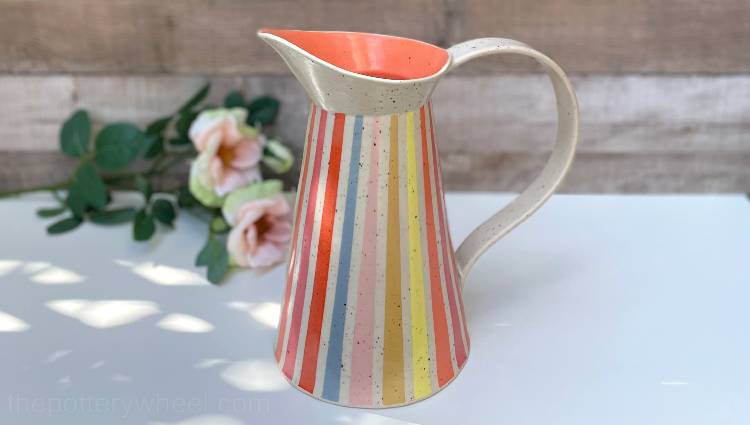Your cart is currently empty!
How Do Kilns Work? – All about How Pottery Kilns Fire Clay
Published:
Last Updated:
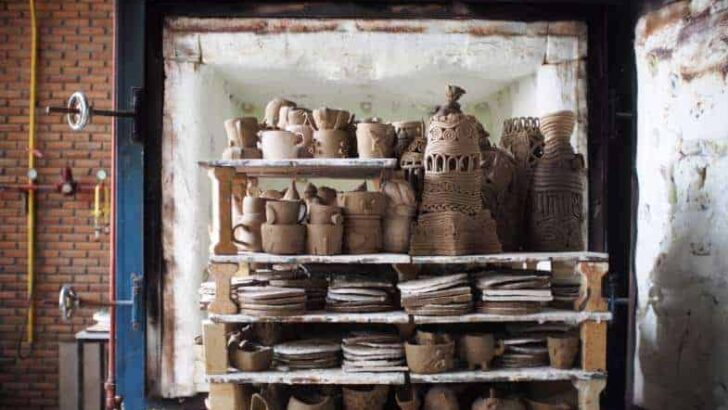
Affiliate Disclaimer
As an affiliate, we may earn a commission from qualifying purchases. We get commissions for purchases made through links on this website from Amazon and other third parties.
There are different types of kiln, and each of them works a bit differently. However, regardless of design, kilns are simply chambers that are heated up to bake clay at high temperatures. In this article, I will look at the question, how do kilns work? I will consider some of the differences between types of kiln. And how this affects how they work when firing clay.
Kilns are either electric or fuel burning. Fuel-burning kilns like gas, wood, and oil burn combustible material to heat the inner chamber. Electric kilns are lined with coiled metal elements, through which a current flows. The resistance in the coil creates heat. This heats the chamber using conduction, convection, and radiation.
Although the end goal with different types of kiln is to fire clay, the way they work is quite different. So, let’s take a closer look at some of these differences to answer the question of how do kilns work.
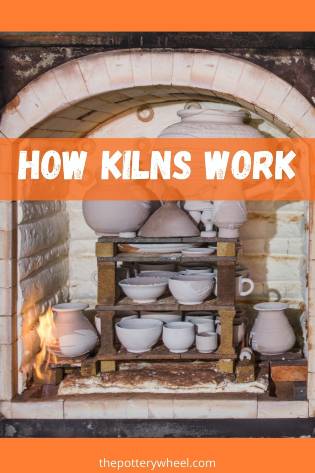
How Do Kilns Work?
This article will look at how electric kilns work, and how fuel burning kilns work. If you want to read about either of these first, you can jump to those sections here:
Electric Pottery Kilns
Amongst potters, electric kilns are the most commonly used. Some of the reasons for this are that modern electric kilns are relatively easy to use. Most have digital control panels that allow you to program your ‘firing schedule’.
Other electric kilns, called Kiln Sitters don’t have digital controllers. Nevertheless, they rely on a mechanical device that is preset to switch off at a particular temperature. As such, KilnSitters are semi-automatic kilns.
The firing schedule is like a timetable of when the kiln will increase in temperature. And the rate at which that increase will take place. Schedules have different segments, and the kiln will heat up faster in some segments than others.
You simply program your schedule and let the kiln run through the firing sequence. In addition to this, although electric kilns are not cheap, a small domestic-sized electric kiln is comparatively cheaper to buy.
Electric kilns come in a huge variety of sizes. Some small electric kilns are a few cubic feet in size and are designed for making jewelry and test tiles. These contrast with colossal kilns designed for industrial pottery production.
How do Electric Kilns Work?
In spite of the differences in size, electric kilns employ more or less the same technology to work. Usually, an electric kiln has a metal outer layer or structure, that is lined with insulating brick.
The insulating kiln brick is soft, porous, and refractory. Refractory means that it can withstand high temperatures without melting or losing its shape.
Grooves are cut into the kiln brick surface, and metal coils that conduct electricity sit in these grooves. These metal coils are called elements and they run around the circumference of the inside of the kiln.
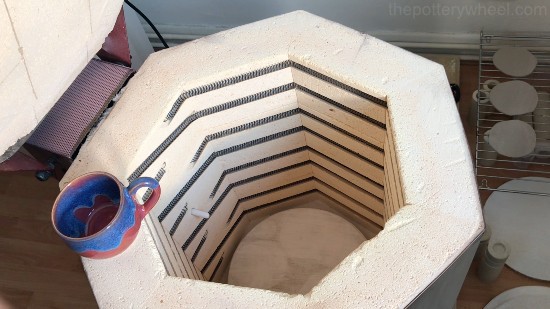
Depending on the size of the kiln, most kilns have more than one element. And each element enters and exits the kiln at a box mounted onto the outside of the kiln. The elements are wired into an electrical panel in this box, and this is where they receive their current.
When the kiln is switched on, electricity flows through the elements. Different types of elements have different levels of electrical resistance. Resistance is the amount that the metal wire opposes the flow of electricity.
The more resistance the hotter the element gets. So, it is the resistance in the electrical element that causes it to heat up.
How does the Kiln Chamber Heat up?
An electric kiln relies on three heating principles to reach the high temperatures required to fire clay.
Convection:
When the kiln is just getting going and heating up the chamber, most of the heat is distributed by convection. As the elements heat up, the surrounding air in the kiln becomes hot. Hot air rises to the top of the kiln and cooler air remains at the bottom. As the temperature in the kiln continues to rise, the cooler area at the bottom is also heated. And in turn, this air rises. This circling of air is known as convection.
Conduction:
The second heating mechanism at play in an electric kiln is conduction. This is the process whereby heat is transferred from one material directly to its’ neighboring material. So, the elements heat up, which in turn heats up the adjacent bricks. Slowly the heat spreads by conduction through the bricks and heats the kiln.
Likewise, once the pottery starts to heat up, heat energy in the ware travels by conduction throughout the kiln load.
Radiation:
The third heating mechanism working in a kiln is radiation. Initially, heat radiates out from the elements. However, as the temperature in the kiln rises, the kiln bricks and the ware itself begin to radiate heat.
This is why a tightly packed kiln will need to be fired for less time than a half-loaded kiln. A tightly packed kiln will radiate more heat once it reaches a certain temperature.
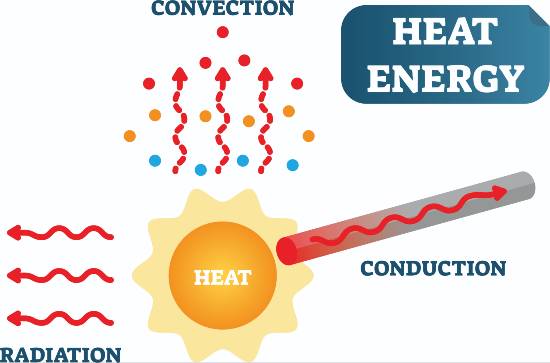
Different Firing Temperatures
Electric kilns are usually categorized according to the maximum temperature that they can fire at. Some electric kilns are designed to reach temperatures around 2012F (1100C). These are often referred to as being suitable for earthenware firing or bisque firing.
Other kilns are able to handle higher temperatures of up to around 2350F (1300C) These kilns are suitable for firing stoneware and porcelain.
Part of what determines what temperature the kiln can reach is the design and insulation. However, an important factor is the kind of elements that are being used in the kiln.
Some elements are designed to work best at lower temperatures suitable for low fire earthenware pottery and bisque firing. Other elements can handle the higher temperatures needed to fire stoneware and porcelain clay properly.
Different Types of Elements
Nickel-chromium wire, or Nichrome elements are an alloy of nickel and chromium. These elements are thinner and heat up more quickly. But they burn out sooner and they are vulnerable to corrosion from sulfur fumes that are created during firing. Nichrome elements are best used in kilns that will be fired to temperatures around 1832F (1000C).
By contrast, Kanthal elements are a blend of chromium, aluminum, and iron. They will heat up to higher temperatures of around 2350F (1300C). These elements also have a coating of oxide which protects them from sulfur fumes.
Nevertheless, Kanthal elements are not invincible. They need a certain amount of oxygen in the kiln atmosphere, otherwise, they deteriorate quickly.
This brings us to another important area in answering the question of how do kilns work. That is the difference between oxidation and reduction.
How do Kilns Work in Oxidation and Reduction
These two terms can sound technical and off-putting when you first hear about them. But don’t be put off! They can be described in a relatively simple way.
When pottery is fired, it’s described as being fired either in an oxidation or reduction atmosphere. Basically, this refers to the amount of oxygen present in the kiln chamber during firing.
If there is a surplus of oxygen in the kiln, it’s described as being in oxidation. If the amount of oxygen in the kiln is deliberately restricted or reduced, this is a reduction firing.
The chemical and physical changes that clay and glaze go through are different depending on how much oxygen is present. Glazes and clay that are fired in an oxidized atmosphere will look different when fired in a reduction atmosphere.
Some kilns are fuel burning. These fuels include gas, wood, and oil. When fuel is burned, it consumes oxygen. It’s possible to reduce the amount of oxygen in a fuel-burning kiln quite easily.
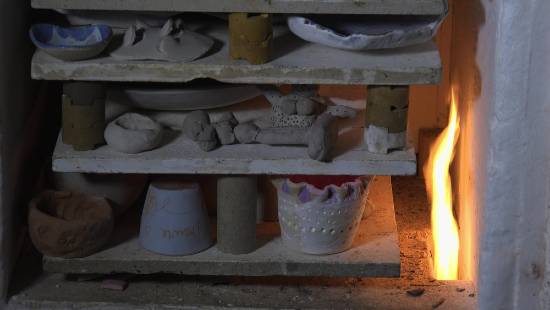
This is done by restricting the airflow and allowing the fuel to burn the existing oxygen in the chamber. By contrast, electric kilns don’t rely on combustion to heat the chamber.
As such the oxygen level in the kiln is not affected during the firing process. As a result, electric kilns normally fire pottery in an oxidizing atmosphere.
Reduction Firing in an Electric Kiln
However, some potters do create a reduction atmosphere in electric kilns. They do this by introducing combustible material into the inner chamber via a port or opening on the kiln.
Some kilns are designed to work as hybrid versions of electric and gas kilns. In hybrid kilns, electricity is used to heat the chamber. Then, a small propane burner is used in a hole at the base of the kiln. The burner creates a reduced atmosphere.
Burning fuel in a kiln creates smoke and fumes that attack the kiln elements. So, if reduction firing is going to be done in an electric kiln, special elements need to be used.
These elements are made from Silicon Carbide and can withstand higher temperatures and harsher fumes present in a reduction atmosphere.
Never, the less burning fuel in a kiln is not just harsh on the elements. It also takes its toll on the kiln bricks. So, let’s take a look now at how kilns work when they rely on burning fuel.
Fuel Burning Kilns
Many of the original fuel-burning kilns were heated by burning coal. Their hay day was during the industrial revolution when coal was the fuel of choice for lots of industry. Coal-burning kilns came in different shapes and sizes including the beehive kiln and the bottle kiln.
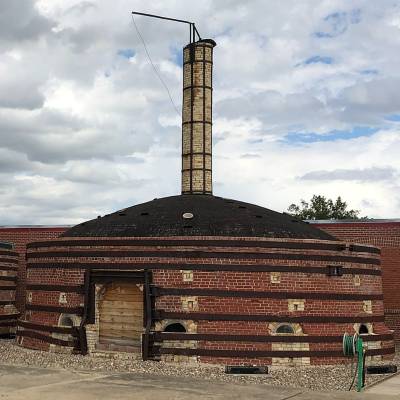
Via Wikimedia Commons
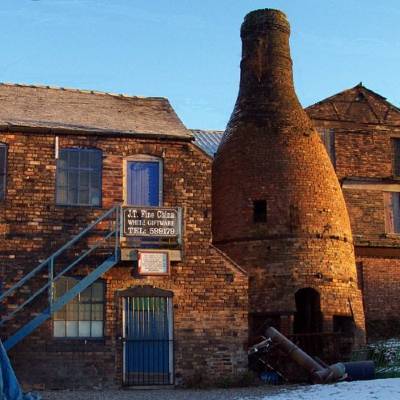
These kilns were large and used for industrial levels of production. However, the vast majority of coal-burning kilns are no longer in operation.
This is partly due to the amount of space required for storing coal and stoking the fires. But it is also related to the amount of fumes and smoke coal kilns produced. Since the Clean Air Act, cleaner fuel sources have been favored.
Gas Kilns
The most commonly used fuel-burning kiln is a gas kiln. If you want to know about gas kilns, read on…
How do Gas Kilns Work?
Gas kilns use a gas flame to heat the kiln chamber. Different types of gas can be used. Common gases to heat kilns are natural gas from a mains supply. Or bottled gas such as butane or propane.
The flame on a gas kiln enters the kiln through a burner port at the base. Depending on the size and design of the kiln it might have just one entry port for the fuel. Or if it’s a larger kiln it will have several.
Like electric kilns, gas kilns come in all sizes, ranging from 2 cubic feet to huge industrial-sized kilns.
Some kilns have a bag wall next to the burner port. This is a short wall on the inside of the kiln next to the entry point of the flame. It normally goes halfway up the inside wall of the kiln. And it helps direct the flame into the kiln and protects the ware from making direct contact with the pottery.
The advantage of using natural gas is that it has a soft flame. Because it is soft, the flame can be elongated and its direction can be controlled. The actual direction of the heat and flame depends on the design of the kilns.
Because fuel-burning kilns require airflow, they need a chimney or a flue. The chimney provides an exit point for smoke and fumes, but it also creates a draft in the kiln. The draft of a kiln is the direction that air and heat are flowing in the kiln. And most kilns are either updraft, downdraft, or cross draft.
Up Draft Kilns
With an updraft kiln, heat from the flame travels from the base of the kiln. It moves up through the chamber and out of a flue at the top.
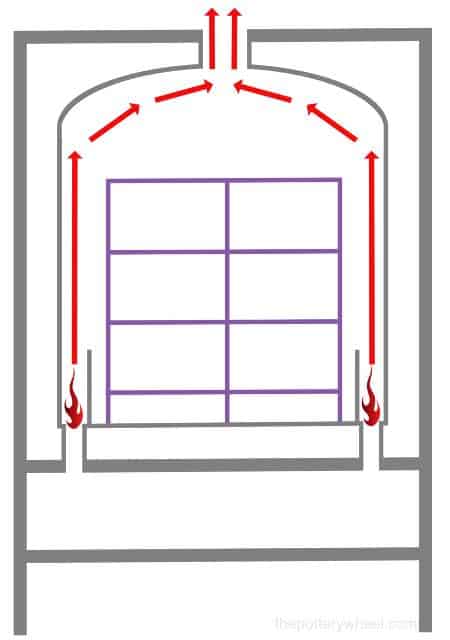
Usually, an updraft kiln will have a burner port on either side at the base. So, flames enter the kiln on the left and right-hand side of the kiln.
These travel up behind a short bag wall and towards the top of the kiln. The flue at the top of the kiln provides an exit point. It also creates a draft. As heat exits the kiln at the flue, air is drawn in through entry points at the base.
One of the drawbacks of an updraft kiln is that flames prefer to take the path of least resistance. A flame will move upwards towards the exit via the shortest route. A result of this is that the pottery in the center of the kiln receives less heat. It can be harder to create a uniform temperature in an updraft kiln.
However, the draft going through the kiln can be controlled using a damper on the flue. This narrows the size of the exit and reduces the flow of the flame up and outwards.
This has two consequences. Firstly, pressure will build up in the kiln and heat will be dispersed more evenly. This helps to create a more uniform temperature. Secondly, it reduces the amount of oxygen in the kiln, creating the reduction atmosphere described earlier.
Down Draft Kilns
Similar to the updraft kiln, a downdraft kiln has burner ports at the bottom edge of the chamber. The flame travels up behind the bag wall and into the kiln. However, unlike the updraft kiln, there is no flue on the ceiling of the downdraft kiln.
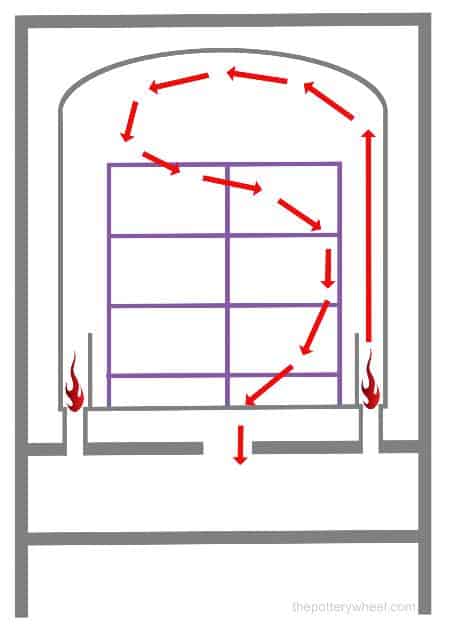
The flames have nowhere to exit at the top of the kiln. Therefore, the heat is forced to travel back down into the kiln. Eventually, the flames and heat find flue at the base of the kiln and exit the chamber there. The flue will have a chimney attached to it which carries the smoke and fumes away from the kiln.
Because the heat from the flame passes through the kiln twice, downdraft kilns are more energy efficient. As with the updraft kiln, the volume of the draft can be controlled with a damper on the flue.
Cross Draft Kilns
In cross draft kilns the flames and heat pass from one side of the kiln to another. The burner port is on one side of the kiln, and the heat passes through holes in a bag wall on the side.
A cross draft draws the hot gases horizontally through the chamber. Once they have reached the other side of the kiln the smoke and fumes exit through on the side.
Traditional anagama kilns of Japan are examples of cross draft kilns. Anagama kilns are long kilns that were often built on a hillside. These kilns rely on the heat in the kiln rising upwards along the sloping hill.
Never the less their design involves a fire box on one side of the kiln. The heat from the fire box passes horizontally through the kiln chamber. And then exits the kiln through a chimney on the other side.
Anagama kilns are wood-burning kilns. When wood burns, it produces a long flame. This is advantageous for downdraft and cross draft kilns where the heat is required to travel. However, anagama kilns are not the only type of wood burning kiln. In the next section, I will look some more at how wood burning kilns work….
Wood Burning Kilns
Wood burning kilns are all largely hand built. They range in size and design. However, a common design for a wood burning kiln is to build an arch shaped brick chamber. These are often large enough to stand up in.
The overall shape of the kiln is that of a long arch. The back end of the arch is bricked up. However, there are gaps in the brick wall which work as exit flues. The flues allow smoke, fumes, and heat to exit the kiln into a chimney that is built on the back.
Once the arch and the back wall have been built, pottery is loaded into the kiln. A space is left free from pottery at the front end of the kiln. This is where the fire will be built and burned.
When the kiln has been loaded with pottery, the front end of the kiln is then bricked up. A gap is left in the bricks at the bottom of the front wall. This is where wood is fed into the kiln to stoke the fire.
Wood fired kilns reach around 2400F (1300C). It takes a lot of work to get the kilns to that target temperature. They require constant attention and usually need to be fed wood every 5 minutes for an entire day.
The particular design described above is a cross draft kiln. Heat, as well as flames from the fire, are drawn through the kiln from one side to the other. As the wood burns, ash from the fire is deposited on the pottery and creates a natural glaze. The direct contact of the flames on the pottery also creates unique patterns.
Types of Flame
Different fuels produce different kinds of flame. This has an impact on how the kiln works. It also plays a key role in the type of pottery produced.
For example, natural gas produces soft flames, and these flames can be made longer or shorter. Wood also can produce long flames that dance about in the pottery. By contrast, propane, which can also be used to fire a gas kiln, produces a shorter stronger flame.
A propane flame is fierce and strong. As a result, it’s not as easy to coax the flame about the kiln. A natural gas flame can be re-directed about the kiln more or less as required. By contrast, the direction of a propane flame is achieved through the clever placement of the burners.
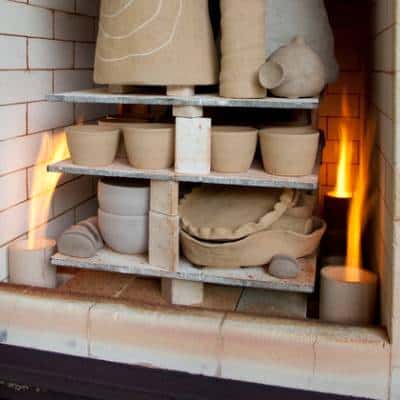
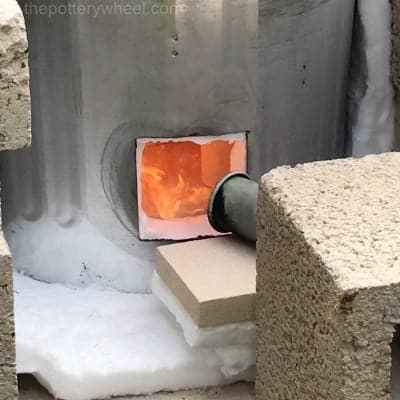
Propane is a popular choice of fuel for another way of firing called Raku. Raku firing involves firing pottery to relatively low temperatures of around 1832F (1000C). And removing the pottery from the kiln with metal tongs when the pots are red hot.
The hot ware is then placed in burnable material like paper or sawdust, and covered with a metal container. The combustible material burns away in the metal container and consumes the available oxygen.
This creates a reduction atmosphere and can produce lovely effects on glaze and clay. The process of raku firing is quite different from how kilns work normally.
Under normal circumstances, kilns are left to cool after firing. And pottery is unloaded once the kiln is at room temperature. This helps avoid the pottery cracking from thermal shock.
However, despite the various differences in firing techniques, fuel burning kilns have a number of things in common. And these shared features are common to how these different kilns work.
Here are some of the shared features of different fuel burning kilns:
Features of Fuel Burning Kilns
- Entry points for the fuel, situated at the base of the kiln
- Exit flues for smoke, fumes, and waste to escape
- The flue is often combined with a chimney to carry the fumes away
- Dampers to control the size of the flue, and strength of the draft
- Ways of controlling the amount of air that can enter the kiln
Intermittent V’s Continuous Kilns
One final feature of how kilns work is the difference between continuous and intermittent kilns.
Intermittent kilns are heated up at the start of a firing cycle. And they are allowed to cool down when the firing schedule is over. The ware is then unloaded. When the kiln is used again this cycle is repeated. Most kilns work this way in small potteries.
By contrast, a continuous kiln stays on for longer periods of time. The ware is fired and removed from the kiln and the kiln stays hot as more ware is loaded. A good example of this is a tunnel kiln, often used in industrial pottery production. Tunnel kilns are sometimes over 200 feet long.
Pottery is loaded onto a truck or conveyor, and travels through the tunnel. The center of the tunnel is hot. As the ware moves towards the hot center it starts to pre-heat. And as it moves out of the exit of the kiln the ware starts to cool.
The air flow in tunnel kilns is often designed to flow in the opposite direction to the pottery. As the ware moves towards the exit of the kiln, it is cooled by air. This cooling air becomes hot. The hot air is encouraged back to the beginning of the tunnel to pre-heat the new ware as it enters.
How do Kilns Work? Final Thoughts
Kilns come in very many shapes and sizes. Probably the biggest difference is whether the kiln works using electricity or fuel. However, large electric kilns use the same principles to fire clay as small electric kilns. And the same can be said of fuel burning kilns. So, although kilns may have lots of individual differences, there are some shared features in how kilns work.

